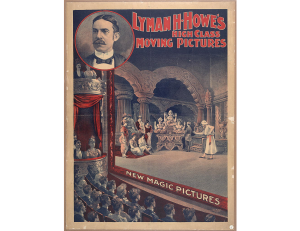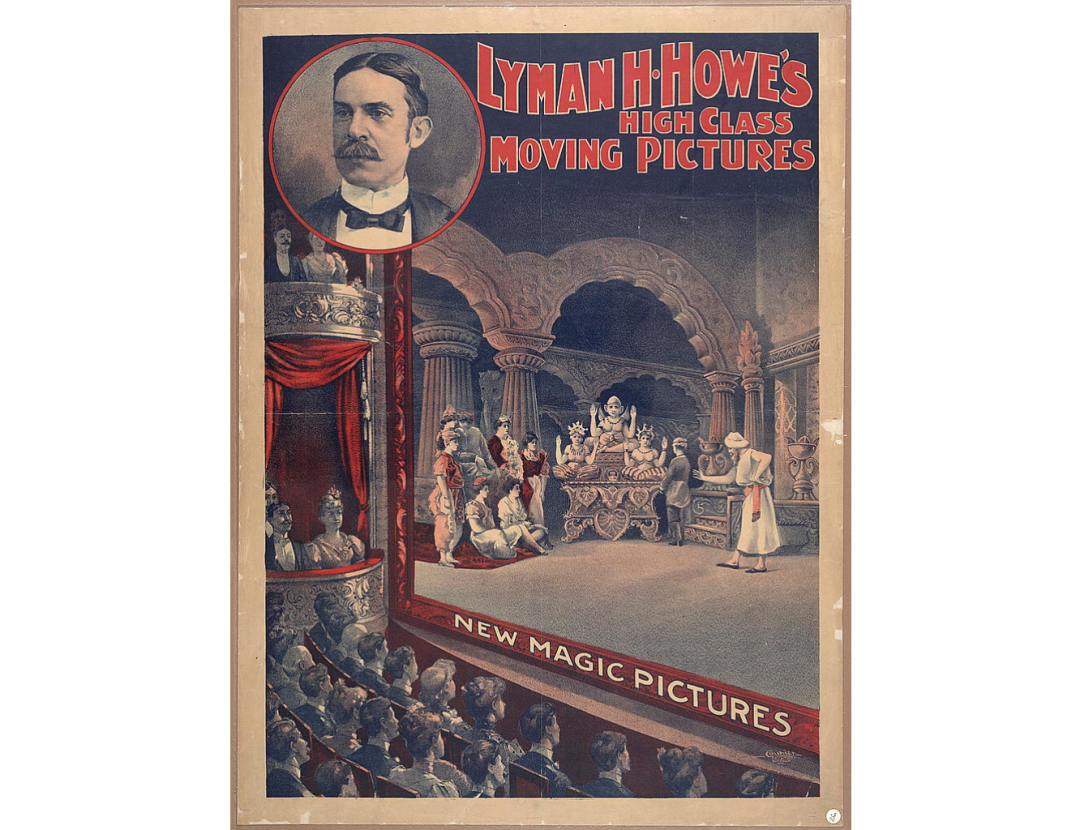
The evolution of cinema has come a long way, as it is an art form where films can now be easily created and shared. In the early 1900s, motion pictures were the new talk of the town as it was a new form of entertainment. Traveling shows brought excitement to those who were unfamiliar with moving pictures. Moving pictures gave audiences the opportunity to witness history, playing a crucial role in the development of cinema. Lyman H. Howe made history as one of the most influential traveling exhibitors of his time. Lyman H. Howe is known for his High-Class Moving Pictures, which combines film with music, sound effects and narration. Howe would then bring this cinema on the road, introducing people to motion pictures and leaving a lasting impact on them and the future of cinema.
Lyman H. Howe’s “High-Class Moving pictures- New Magic Pictures” was a promotional poster in which advertised Howe’s traveling exhibition of films. This poster was created in the 20th century around 1898-1910 by a firm called Courier Lithograph Company in Buffalo, NY. This firm was known for producing posters for travel shows, and Howe essentially hired them to produce posters for his exhibition. This poster was created to inform the public about Howe’s work and attract audiences to the motion pictures, mainly in towns that did not yet have theaters. Upon seeing the exhibition, many agreed that it was “by far the best in the moving picture line ever seen in these parts” according to “6 Hard Times for the Roadmen: Lyman H. Howe, the Premier Traveling Exhibitor.” This proves that many were pleased with the opportunity to see the exhibition, and it was greatly appreciated. Upon his exhibition he began gaining praise and recognition for his work, as one review noted, “He has come to be recognized as the most enterprising and most successful moving picture exhibitor in America.” (6 Hard Times for the Roadmen: Lyman H. Howe, the Premier Traveling Exhibitor.”). This not only changed the trajectory of many American lives but also became a pivotal success in his career.
In the beginning of the 20th century, technology, industrialization, and society were changing rapidly. One of the newer technologies that brought excitement to people was motion pictures, as it was a completely new form of entertainment. Lyman H. Howe was a key pioneer in this field, as he brought motion pictures to life in his exhibition which gave those who did not have permanent theaters a chance to experience film. Howe promoted his shows as respectable and family friendly, which would set them apart from cheap Nickelodeons. When understanding American history, it is important to know that motion pictures were this new era of entertainment, but they also reflected the rise of mass culture and consumerism. This reflected the beginning of new forms of public leisure. During this time, Americans were eagerly embracing the new forms of entertainment and the technological advances being made. Howe’s exhibitions were designed to excite audiences and according to the “Audio Visual Reviews 1986” it states “His roadshows took gasping audiences for a tour of the Panama Canal and their first ride in an airplane,” showing how he was able to excite audiences while educating them, leaving a lasting impression. Howe’s poster gives viewers a glimpse of how people experienced early cinema along highlighting their excitement and cultural values.
When viewing Lyman H. Howe’s poster, he combines both visual composition and word choice to get his message across. In the poster, the words “High Class” and “New Magic Pictures” are evident on purpose. “High Class” portrays that Howe’s motion pictures are meant to be shown to those who are respectable and families. He wanted to make clear that his traveling exhibition is nothing like cheap nickelodeons. “New Magic Pictures” is in large to show the audience that this is new technology of motion pictures, this also gave the audience something new to look forward to. In the poster, Howe is shown in the top left corner, indicating his responsibility for this exhibition. Another aspect to look at is the audience in the poster looking at these new motion pictures with a bit of happiness as some have smiles on their faces. This shows that audiences are going to enjoy the new motion pictures and appreciate having even experienced something like this. The advertising on Howe’s poster did a good job of influencing others as it reassured people that they would be entertained, and it would be educational and appropriate. Howe’s poster gave people a glimpse into the beginning of what the future of cinema can hold.
Works Cited:
Lyman H. Howe’s high class moving pictures – new magic pictures / Courier Co. litho., Buffalo, N.Y. https://www.loc.gov/item/97520513/
- High-Class Moving Pictures: Lyman H. Howe and the Forgotten Era of Traveling Exhibition, 1880-1920 on JSTOR. https://www.jstor.org/stable/j.ctt13x18p7.10?searchText=ti%3A%22High-Class+Moving+Pictures%3A+Lyman+H.+Howe+and+the+Forgotten+Era+of+Traveling+Exhibition%2C+1880-1920%22&searchUri=%2Faction%2FdoBasicSearch%3FQuery%3Dti%253A%2522High-Class%2BMoving%2BPictures%253A%2BLyman%2BH.%2BHowe%2Band%2Bthe%2BForgotten%2BEra%2Bof%2BTraveling%2BExhibition%252C%2B1880-1920%2522%26so%3Drel&ab_segments=0%2Fbasic_phrase_search%2Fcontrol&refreqid=fastly-default%3A6e792e2c49ae68c339090b9c2c0cac7c&seq=1 Date Accessed: November 20th, 2025
– This source goes into depth about Howe’s role as a pioneer in his exhibition of traveling films and shares insights on how he shaped early cinema. Also, informs about the historical significance of his poster.
- Research Databases, EBooks, Discovery Service. https://research.ebsco.com/c/dq7v4l/viewer/pdf/nedw7q2whj. EBSCO, Date Accessed: October 2nd, 2025
– This source sheds light on Howe’s traveling exhibition calling it the “turn of the century” and shares his accomplishments and what he has done with these films.
- Traveling Exhibits: Howe’s Early Years, 1856-1890. https://www.jstor.org/stable/j.ctt13x18p7.6?seq=1 Date Accessed: October 2nd, 2025
– This source discusses how Howe’s goal was not only to entertain but to teach and shows how much he wanted to educate. Also showed how these exhibitions shaped entertainment choices.
